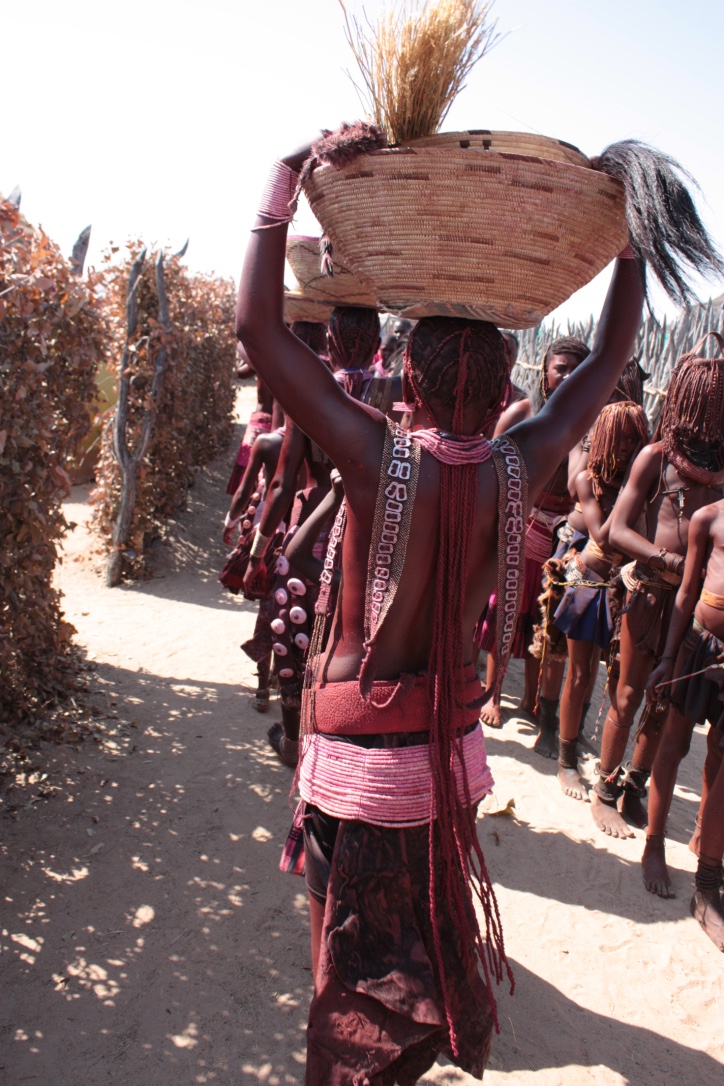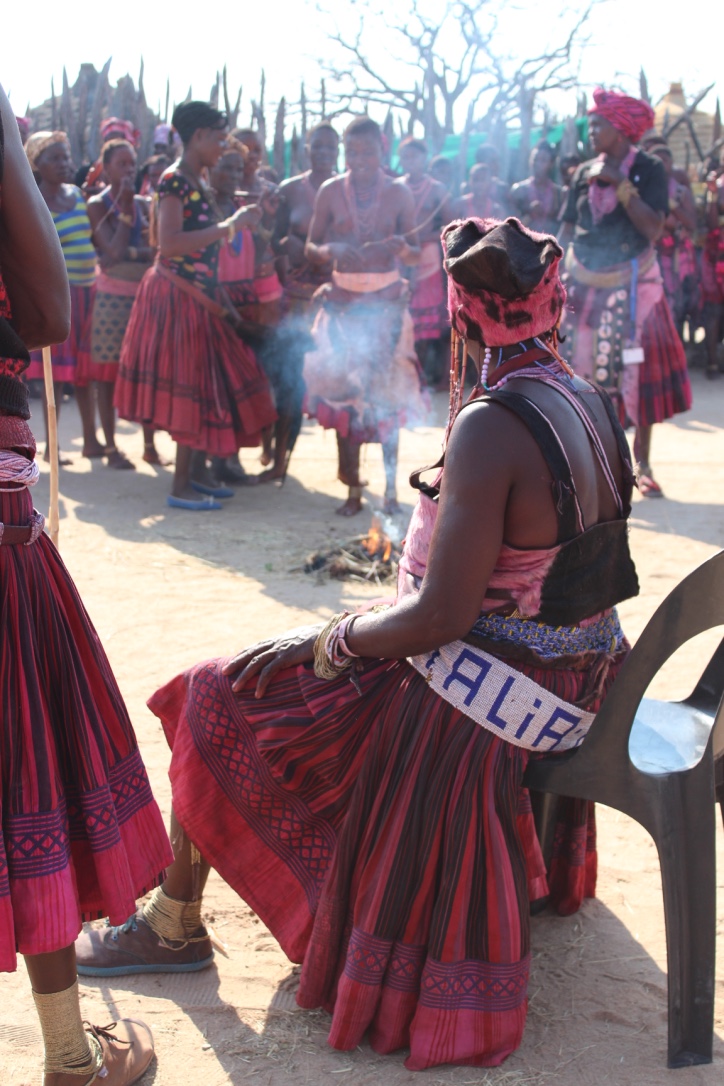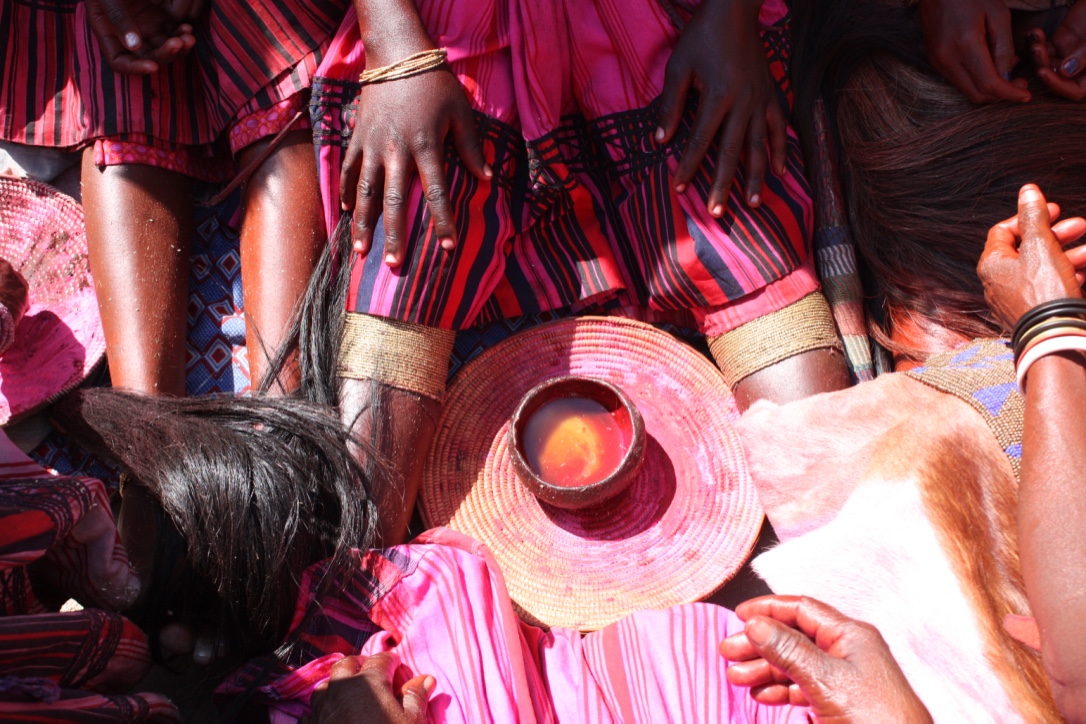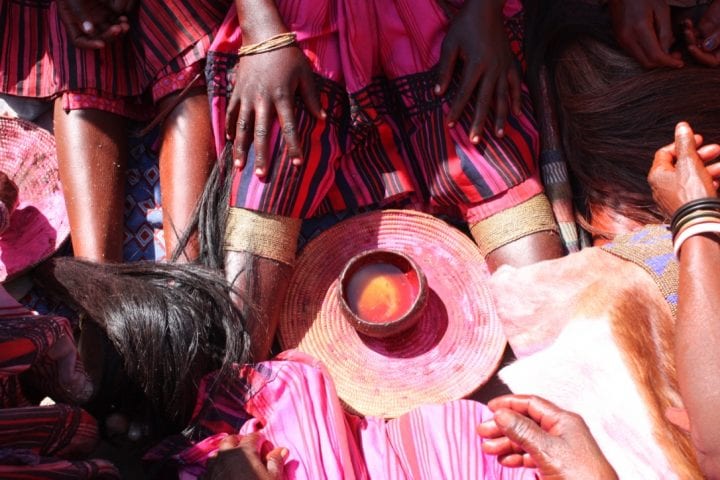The Lutheran Condemnation of the Initiation Ritual of Girls in Namibia
Saara Kuoppala
When the first Finnish missionaries arrived in South West Africa (SWA), now known as Namibia, in 1870, the initiation ritual for girls, known as Olufuko, was an important part of Ovambo culture. The missionaries did not approve of the practice and therefore it was banned in the first church regulations. In recent years, this initiation ritual has been at the center of a heated public debate. The launch of the Olufuko Cultural Festival in 2012 produced much debate in Namibia. On the one hand, high-profile politicians, such as Namibia’s first president Sam Nujoma, promote Olufuko as an authentic Namibian practice. On the other hand, Namibia’s biggest church, the Evangelical Lutheran Church in Namibia (ELCIN), which has its roots in Finnish mission work, sees the practice as “paganistic” and against Christian values.
The girls’ initiation ritual among the Ovambo people in northern Namibia is known as Ohango, Olufuko or Efundula. These are effectively the same ritual with only minor differences. From the beginning of the prosletyzing efforts of the Finnish missionaries in the 1870s, the Lutherans viewed the indigenous traditional practices as paganistic. In this essay, I examine whether there are similarities between the argumentations of the early Finnish missionaries and the contemporary Lutheran Church in Namibia.
The University of Namibia’s Multidisciplinary Research Center conducted research on the Olufuko rite in 2016. As a member of the research team, I undertook ethnographical work at the Olufuko Cultural Festival and stayed with the initiates throughout the whole ritual. I observed the different phases of the initiation rite and interviewed several informants on this topic.
Throughout my fieldwork I noted that public discussion in Namibia is full of diverse views on what happens in the Olufuko rite. In these discussions there are arguments implying that the initiates are wed as minors or that the girls have to go through sexually-oriented acts in which a male ritual leader tests the virginity of the girls. Therefore, I feel the need to shortly describe what I observed at the Olufuko Cultural Festival in 2016.
The town of Outapi arranges the annual Olufuko Cultural Festival at the end of August and beginning of September. The festival is a large-scale cultural festival that includes arts and crafts and food stalls. The girls’ initiation ritual forms the central feature of the festival, with large numbers of young women being initiated. The initiation ritual lasts for six days and the ritual leaders were exclusively women. There were no sexual acts involved in the ritual and men could only participate as audience members at the festival. The initiates were between the ages of 15 and 25 and they were dressed in traditional attire. An initiation ritual prepares a young woman for marriage, but these girls were encouraged to stay in school and finish their education before getting married. There are no statistics available that would illuminate what happens to the girls after being initiated. Even so, I had a chance to interview girls who had gone through the initiation and they were still in school and not married. Thus, it is safe to say that not all of the initiates are wed directly after the initiation.
The Impact of Finnish Missionaries
When the first Finnish missionaries arrived in SWA, they represented the Lutheran denomination with a pietistic twist. The conversion process was slow and it took thirteen years for the missionaries to baptize the first Ovambo. As is typical with Pietism, the Finns preached about the importance of giving up traditional practices. According to historian Kari Miettinen, the Finnish missionaries strongly opposed the Olufuko initiation ritual. The practice was strictly forbidden and there were no attempts to Christianize it. The first church regulations of the Evangelical Lutheran Church in 1924 banned the rite. The regulations ordered anybody who sent a girl for initiation to be excommunicated from the church. The condemnation of the rite created conflicts because Christian girls were attending the initiation ceremony against the will of the missionaries.
In a study of Finnish mission history in Africa published by the Finnish Lutheran Mission Society, Matti Peltola, a former missionary, describes the Ohango initiation ritual as a celebration of the Ondonga people. The Ohango rite was arranged every other year in the fall. The festivities had different phases and each was distinguishable. Peltola describes that some of the ritual practices were “pagan” and were carried out in private. He describes how during these acts the girls were taught things that went against Christian values. Peltola does not specify what these acts were and how they were immoral.
Among the first Finnish missionaries was Martti Rautanen. In a letter to the German missionary Carl Hugo Hahn, Rautanen describes how the Ondonga king Kambonde allowed Christian girls to get married without going through the initiation. Rautanen explains to Hahn how he told the king that baptized Christians had been liberated from indigenous traditions through their baptism. Baptized Christians had supposedly become people of God and therefore were not under the influence of the traditional gods of the Ondongans.
Peltola argues that the girls’ initiation ritual became a problem for the Lutheran Church mainly because of the Christian youth. In the first years of the Lutheran congregation, the young men went to the Ohango ceremonies to pick their brides. For this reason, as early as 1885 Rautanen denied the possibility for the youth of the region to take part in Ohango because he viewed it as being closely connected to indigenous religions. The actual main problem, according to Peltola, was that there were Christian girls who were baptized who were still attending the initiation. Rautanen ordered that a local should reject the traditional ritual practices of their culture after being baptized as they were not compatible with Christianity. Girls were even threatened with excommunication from the Lutheran church if they participated in the Ohango rite.
ELCIN and the Olufuko Festival
The Olufuko Cultural Festival is promoted as an reenactment of Namibia’s cultural heritage and it was created to attract tourists to Outapi and to stimulate the local economy. Since the launch of the festival in 2012, the ELCIN has strongly opposed the event. The ELCIN had a pastors’ conference at Ongwediva in July 2012. After this conference, the ELCIN released a pastoral letter via the press. The letter condemned the Olufuko practice as being “against Biblical teachings and principles”. According to the ELCIN, “it infringes upon Christian values and morals”. With this letter, the church pleaded with its members to stay away from Olufuko. The letter was signed by Bishop Shekutaamba Nambala on behalf of all ELCIN pastors. Kim Groop points out that the press release contained strong binary connotations. Groop mentions deveral examples, such as light versus darkness and decency versus sexual immorality. According to Groop “Olufuko in this press release seems to represent the old, dark and immoral whereas the church represents, or wants to promote, a message of light, newness and morality.” Groop continues to argue that “[i]n this sense ELCIN seems to stay relatively true to its Finnish Pietistic heritage.”

Over eighty young women were initiated at the Olufuko Cultural Festival in 2016. Photograph: Saara Kuoppala.

The ritual leaders (Namunganga) were exclusively women. Photograph: Saara Kuoppala (2016).
In an interview with retired Bishop Josaphat Shanghala in 2016, the bishop emphasized the church’s stance by stating that tradition, which includes Olufuko, and Christianity travel down separate paths. According to him, tradition and Christianity are like two railway lines that go parallel but never meet. In his view, Olufuko is a form of cultural worship that does not belong to the church because the church has a different culture. As a solution, Bishop Shanghala suggested that those who want to practice traditional things, such as Olufuko, should secede from the church and practice their tradition outside it. Nonetheless, if they want to be a part of the church, they would have to abandon their tradition, including its ritual practices.

The skin of the initiates was covered with red ochre oil. Photograph: Saara Kuoppala (2016).
Dr. Abisai Shejavali, who is the former head of the Council of Churches in Namibia, wrote a piece in The Namibian in 2012 and explained why the Lutheran Church is against Olufuko. According to Shejavali, the Lutheran Church consists of baptized people who believe that they have been delivered from idolatrous worship. Shejavali emphasizes that traditional rites, such as Olufuko, do not have anything to offer to Christians. A baptized person “has emerged as a new being” and therefore old customs should be abandoned.
According to those I interviewed at the festival, the girls and especially their mothers are threatened with excommunication if they are associated with the initiation rite. My informants told me that after taking their daughters to the Olufuko rite, some mothers had to go through a schooling program at their church in order to atone for their sins. One interviewee said that her mother had been banned from the Sunday sermon because of her participation in Olufuko. She had to listen to the sermon from outside the church. Nevertheless, Bishop Shanghala pointed out that the church does not excommunicate its members who take part in Olufuko. Instead, the church disciplines them through education. According to Shanghala, the church provides counselling because people are doing things without knowing that they are making mistakes. He continued that it is the church’s duty to guide its members to the right path.
According to an article published in the New Era newspaper in 2017, Bishop Shekutamba Nambala condemned the practice of Olufuko during a sermon in 2017. The article claims that Bishop Nambala had hinted “that parents who took their children to the Olufuko Festival may in the future be stripped of church privileges, including receiving holy communion.” Not to be able to attend the to Holy Communion is a severe punishment in a country where the majority of the population are Christians.
Conclusion
The revival of the girls’ initiation ritual has led to heated discussion in Namibia. The ELCIN is strongly opposed to the practice, as were the early missionaries in the nineteenth century. There appear to be similarities between the early Finnish missionaries and the contemporary ELCIN regarding their viewpoints on tradition.
As Kim Groop points out, the ELCIN’s press release has strong binary oppositions. Olufuko and tradition in general represent a dark and immoral life, whereas the Lutheran Church represents the light and righteousness of Christian life. This binary view was also present in the worldview of early Finnish missionaries. Africa was seen as a dark and “heathenistic” continent, whereas Christianity was seen as a flaming torch in the dark. The missionaries saw it as their duty to bring light into the Dark Continent through their Christian message.
Both the early Finnish missionaries and the ELCIN perceived that there was (and is) no room for old traditional practices in the Christian life of Namibia. According to them, Lutherans are liberated from these traditional practices at the moment that they are baptized. The girls’ initiation ritual is considered to be an important issue to both parties that is worthy of severe punishment. The missionaries threatened baptizsed Christians with excommunication, whereas the ELCIN, which has not excommunicated its members in decades, threatens its members with a cut in their church privileges (including Holy Communion).
In conclusion, the biggest problem for both sides appears to be the fact that Christian girls were (and are) initiated. Mixing tradition with Christian life was and still is seen as syncretic and not suitable for Christians. It seems that ELCIN and the early Finnish missionaries understand Christianity as an attribute that does not include indigenous traditions. In brief, if one is baptized as Christian, it signifies that one should desert his/her traditional practices.
Bibliography
Akuupa, M., National culture in post-apartheid Namibia: state-sponsored cultural festivals and their histories. Basel: Basler Afrika Bibliographien, 2015.
Groop, K. S., Between Pietistic Heritage and Olufuko Revival: Female Initiation and the Evangelical Lutheran Church in Namibia. Journal of Theology for Southern Africa 150, 2014, 85–111.
Heininen, S., Suomalaisen lähetystyön kriisi: Martti Rautasen kirjeet Carl Hugo Hahnille 1888–1895. Helsinki: Suomen kirkkohistoriallinen seura, 2019.
Kadhikwa, S., ELCIN denounces same-sex marriage and Olufuko. https://neweralive.na/posts/elcin-denounces-same-sex-marriage-and-olufuko, 2017.
Kautondokwa, E., Olufuko revisited: Female initiation in contemporary Ombadja, Northern Namibia. University of the Western Cape, 2014.
Kuoppala, S., Reviving Tradition at the Olufuko Festival 2016 – Girls’ Initiation Ritual in Contemporary Namibia. University of Helsinki, 2018.
Miettinen, K., On the Way to Whiteness: Christianization, Conflict and Change in Colonial Ovamboland, 1910–1965. Helsinki: Suomalaisen Kirjallisuuden Seura, 2005.
Peltola, M., Sata vuotta suomalaista lähetystyötä 1859–1959. Helsinki: Suomen lähetysseura, 1958.
Salokoski, M., How kings are made – how kingship changes: a study of rituals and ritual change in pre-colonial and colonial Owamboland, Namibia. Helsingin yliopisto, 2006.
Shejavali, A., Olufuko: Why The Church Is Against This Initiation Rite.
https://www.namibian.com.na/index.php?page=archive-read&id=102771. 2012.
About the Author
Saara Kuoppala is a doctoral student at the University of Helsinki. She has studied theology and African studies in Helsinki and Namibia. Her doctoral thesis focuses on the revival of Olufuko and the debates surrounding the ritual.

